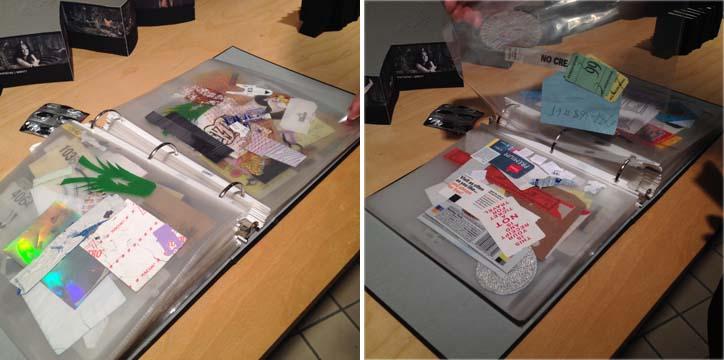Art of the Book at Cooper Union
The genre of Artists Books—in which a book is an art object in itself—offers a broad platform for exploration. In an exhibition that opened on Tuesday, at the Cooper Union
Foundation Building, the opportunity to delve into anything personally meaningful that springs to mind was excavated by students of Professor Margaret Morton.
From the cultural ethos of
New York City compared to that of Harare, the capital of Zimbabwe, to transforming quotidian trash into art; understanding formative life experiences (one’s living and working space, for
example) in 3-D; personal insecurities as manifest in a "book" that denies a reader access; aspects of time and space, in actuality, or within the mysterious realm of a book’s own peculiar
plane. These subjects and more are evident in the works on view, with a few examples here; the texts are by the artists.
Art of the Book continues through Friday,
December 14. The Cooper Union School of Art, Foundation Building, 2nd Floor Lobby, 7 East 7th Street, NY, NY. Information. Directions. The course in which
these artists books were made is taught by Professor Margaret Morton.

Lara Smithson | To be turned of at 17:00 (above)
Every day the man made Cascata delle Marmore is turned on and off. The waterfall was built in several stages between 271 BC and 1787, as part of an attempt to redirect the Vetino River in Italy. Today most of the water runs through a hydroelectric power plant, and the Cascata delle Marmore is preserved as a tourist attraction. Its controlled operating hours reduce a seemingly natural waterfall to a leak. This book depicts the Cascade in a series of oil paintings on glass panels, which are joined in an accordion fold. Light is allowed to pass through the whole book when it stands open or sits closed and illuminates the paintings so their marks can be seen. Two photogram versions of the book also exist on Multi-Ortho-Litho Film, the darkroom process creating these renditions using light, connecting the various realizations.

Edbert Wang | QWERTY (above)
In this digital age, many people are reading on their electronic devices, as opposed to printed text. The pages show the layouts of different keyboards used all over the world, incorporating foreign languages into functional structures. Some of these structures have small differences, while others are wildly different. The original QWERTY keyboard layout that we’re all familiar with was actually designed as a means to slow down the writer, so the original typewriters can keep up. This book shows the differences between different keyboards, and how foreign languages adhere to this conventional layout.

Taylor Woods | Sweet Nothings (above)
Designed as chocolate bars,
these books focus on the racialized associations between African American skin color and food. Many times the shade of one’s skin is referred to in terms of types of chocolate: white
chocolate, milk chocolate, dark chocolate, etc. These references rely on context, personal feelings, and which aspect of chocolate you are using in your comparison….The comparison is
seen by the speaker as a way to identify a color and is experienced by the person being described as a measure of the speaker/perceiver’s intimacy with them, as this person feels endeared or
demeaned to an edible object in the process….

Ian Langehough | Pocket Diary (above and below)
This diary is a collection of every small item that has found its way into my pants, shirts and coat
pockets. Instead of tossing these items out, I decided to collect them beginning on January 1, 2013, placing them inside laminated sheets which are stored in a three-ring binder. As the
collection grows, one might be able to recognize patterns, create small narratives or appreciate the interchangeable collaging that the clear sheets allows. It interests me how this group of
objects that typically ends up as garbage can instead conjure memories for the author as well as the reader of this book. 
Visit The Book in Motion, an interactive website created by Professor Morton, which presents projects from this course executed between 1995 and 2005.


